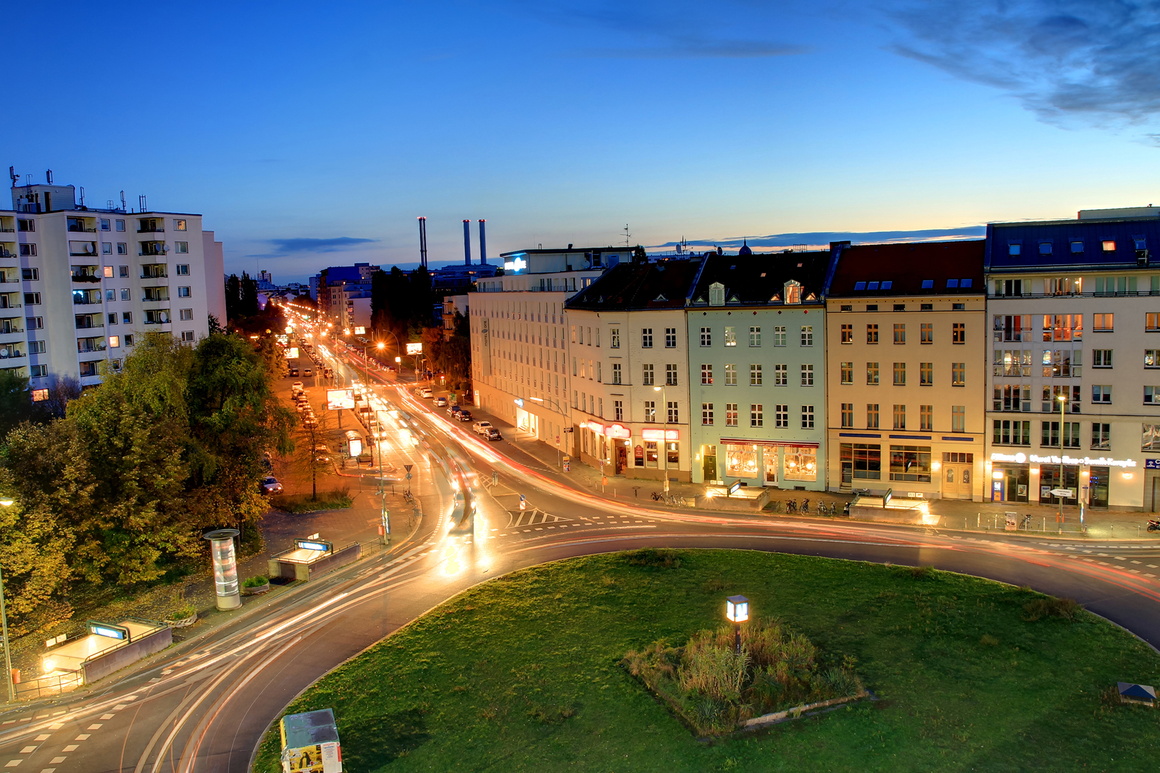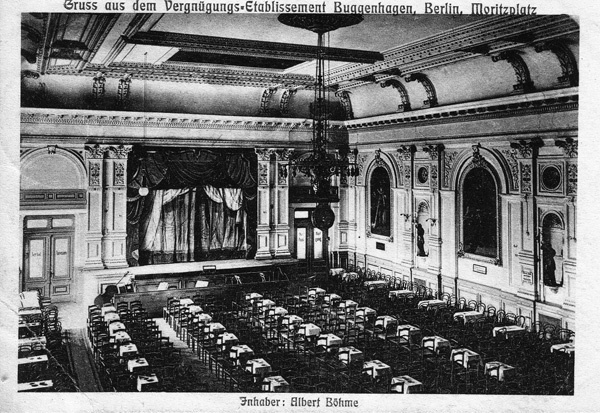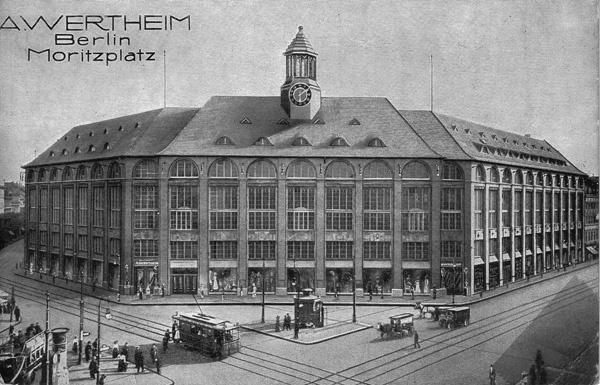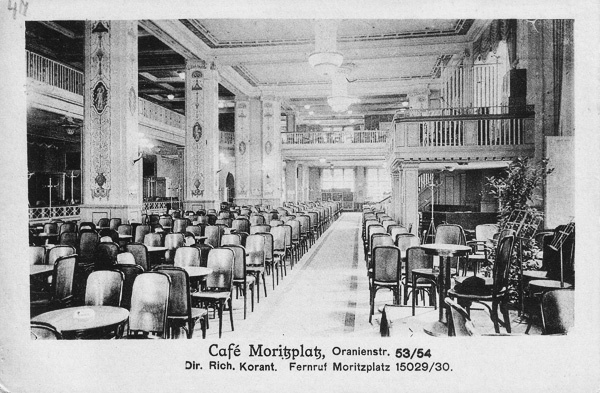
Moritzplatz
The history of Moritzplatz
By means of a supreme cabinet decree in April 1802, Queen Luise allowed the residents of the suburbs of Cölln (the historical name of Berlin) to call themselves citizens of Luisenstadt. In the course of the following decades, two Prussian kings and several renowned urban and landscape designers, including Karl Friedrich Schinkel, Peter Joseph Lenné and James Hobrecht, participated in the planning for a systematic building development. Around 1840, Lenné drew up a development plan for the Köpenicker Feld that characterises Luisenstadt up till now. The rhombic square, later Moritzplatz, is a square turned upside down due to the continuous and intersecting streets (Oranienstrasse and Prinzenstrasse). Its layout was being made symmetrical to Heinrichplatz in the axis of Oranienstrasse. Since traffic from the city centre hit Luisenstadt (today Kreuzberg) first at Moritzplatz, it became the most important of the three successive squares: Moritzplatz, Oranienplatz and Heinrichplatz.
Moritzplatz has presumably been named after Moritz Prince of Orange, Count of Nassau-Dillenburg (1567-1625), since 7 April 1849.
Evidence of the first settlements in what is now Kreuzberg goes back to the 17th century to the Huguenots, who were seeking protection from the persecutions of Louis XIV. The district experienced its first upswing when French religious refugees planted magnificent gardens and brought numerous varieties of fruit and vegetables, which were exotic at the time, to Berlin. Among other things, lemons, oranges and artichokes were cultivated in greenhouses. In its western section, the street, officially christened Oranienstrasse in 1849, was popularly called Orangenstrasse (Orange street). Whether the name comes from the place of origin of the many Huguenot refugees, the southern French principality of Orange, or was named that because French gardeners grew oranges in the greenhouses, has not been clearly clarified to this day.
In 1872, the synagogue association Luisenstädtischer Bruderverein Ahawas Reim was founded, with the aim of establishing a place of worship of their own for all the Jews living in Berlin's southeast, residential and commercial districts. In the same year, an exhibition hall for finished products was built on the second courtyard of the Prinzenstrasse 86 property (today Aufbau Haus). The synagogue association acquired this room and set up its own synagogue there. For unknown reasons, the synagogue association sold the building around 1909, which was subsequently converted into a theatre (probably the Buggenhagen Theatre) by the famous architect Oskar Kaufmann.
In cooperation with the Friedrichshain-Kreuzberg District Museum, a commemorative plaque was erected on 5 October 2011.


Moritzplatz became the epitome of urbanity from the mid 19th and early 20th century. Large department stores such as Pietzker, Knaben- und Mädchenbekleidung (clothing for boys and girls), and especially Wertheim had their headquarters here. The range of luxurious goods could not be surpassed. Where the Prinzessinnengärten (princess gardens) are today, the Wertheim department stores' colossus, completed by architect Eugen Schmohl in 1913, dominated the square with 27 wide window axes.
Directly opposite – on the site of today's Aufbau Haus – one of the largest restaurants and entertainment venues on the square had opened: The Bierquelle Aschinger AG with its concert hall and the adjacent Buggenhagen Theatre, which corresponded in its area to the existing building of today's Aufbau Haus (former Ertex Factory / Bechsteinhaus see History after 1945). There were a number of other dance and entertainment establishments, some of which were located several times on the square, partly with seating for over 1,000 people (Konzertcafé Moritzplatz).



There was heavy traffic on the square, which at the turn of the century was dominated by horse-drawn omnibuses bringing workers, employees, pleasure-seekers and consumerists from Berlin and travellers from all over the world to Moritzplatz.
This changed not least because the Wertheim Group invested the unbelievable amount of five million Reichsmarks in a change of route in order to get a direct underground connection to the world-famous department store on Moritzplatz.
Then, in April 1928, the double-track underground station designed by Peter Behrens (architect for Siemens and Deutsche Bahn), today's U8, was put into operation. The once magnificent underground station is a listed building and is still covered with greenish tiles (Richard Blumenfeld AG, Velten). Under the platform is a 40-metre-long tunnel (a transfer station was also planned), which served as an air-raid shelter during the Second World War and later as a training site for the US armed forces. After 1961, this was the last stop in West Berlin before the U-Bahn travelled via the closed East stations of this line in the direction of Wedding.
Like (almost) no other square, Moritzplatz reflects Berlin's history on a smaller scale. "Sleeping beauty" was the title of an article in the newspaper Tagesspiegel of 10 July 2010 about the Aufbau Haus building project and the city's commitment to changing things around here.
Research and text: Annette Kusche, Head of Communications Aufbau Haus until 2015
Many thanks for the knowledgeable support to the Archiv District Museum Friedrichshain-Kreuzberg (Ludmilla Budich); the Citizen Association Luisenstadt (Wolfgang Pohle), the Technical Office of the BVG (Martin Renz)
Source selection
Berliner Bezirkslexikon Friedrichshain-Kreuzberg Band 1 von A bis O, hrsg. von Hans-Jürgen Mende und Kurt Wernicke, Edition Luisenstadt, Berlin 2002
Kleine Kreuzberg Geschichte, Martin Düspohl Kreuzberg Museum (HG), Berlin Story Verlag, Berlin 2009
Kreuzberg und seine Gotteshäuser Kirchen - Moscheen - Synagogen Tempel Kreuzbergmuseum, Marina Wesner, Berlin Story Verlag, Berlin, 2007
Schinkel-Wettbewerb 1982/83 Planungsmaterialien 1 ff.
Synagogen in Berlin. Teil 2. Zur Geschichte einer zerstörten Architektur 1983, Berlin Museum Stadtgeschichtliches Museum
